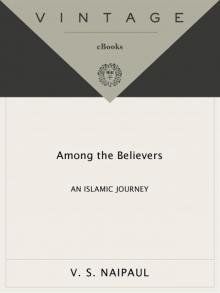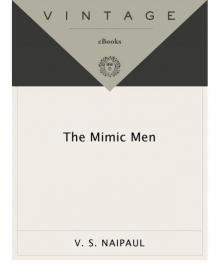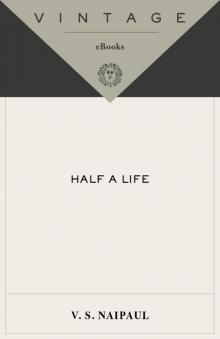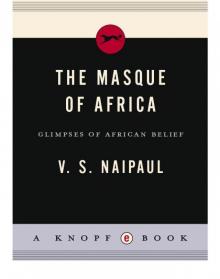- Home
- V. S. Naipaul
The Masque of Africa: Glimpses of African Belief Page 2
The Masque of Africa: Glimpses of African Belief Read online
Page 2
From the gatehouse a paved path as straight as a Buganda road led through the brightness of bare ground to the main building and the darkness of the entrance there below the eaves that came down almost to the ground. All about the edge of this bare area were little huts, some rectangular, some round. These huts were for attendants who looked after the place and especially looked after the fire in the open yard which symbolised the Kabaka’s life. Why was the ground so bare here? Wouldn’t grass have been more welcoming? It was suggested that snakes were easier to see on bare ground.
Inside the tomb itself, on the left of the entrance, in the abrupt gloom, and not immediately noticeable, was an old woman sitting on a purple-striped raffia mat, one of many raffia mats just beyond the entrance, these raffia mats providing the only colour in this part of the tomb. The old woman was bundled up in a long blue-patterned dress of cotton, a little restless in limb, withdrawn, unseeing, as became a watcher in the tomb. She was considered a wife of the dead Kabaka, and as such was privileged. If, as might happen, the spirit of the dead king bestirred itself and wished to be served in any way, she was there for him. She had a collapsed old woman’s mouth, and was pale from her life away from light. She did this vigil for a month at a time; she handed over then to another old woman as privileged as herself.
Kabakas did not die. They disappeared, and went to the forest. The “forest” was just in front, in the inner part of the tomb, screened by brown bark-cloth, hanging down all the way from the top of the dome, like a fire curtain in a theatre. It was absolutely essential, in this kind of building, for everything to come from the local earth. Nothing was to be imported. The religious requirement made for a kind of unity, and a strange beauty. The dome was held up by wooden pillars, trimmed tree boughs, which didn’t conceal what they were, and by twenty-two circular beams made from tightly-bound reeds. Those twenty-two beams stood for the twenty-two clans of Buganda.
The burial of a Kabaka was not straightforward. It was hemmed in by rituals that would have come from the remote past (remote, since people without writing and books cannot remember beyond their grandparents or great-grandparents). The corpse of the king would have been dried over a slow fire for three months. Then the jawbone would have been detached and worked over with beads or cowries; this, together with the umbilical cord, also worked with beads, and the penis and testicles, in a pouch of animal skin, was what would have been buried here. The rest of the body, the unessential man, so to speak, would have been sent somewhere else; but this part of the ritual remained obscure. I could get no direct answer.
On a metal rack in front of the bark-cloth hiding the forest were the fearful spears of the great Mutesa, iron and bronze and brass, some of them truly imperial things, speaking of wealth and murder: gifts from the Arab merchants or obtained from them by barter. They were the only foreign things in the tomb. There was also a reproduction of Mutesa’s wide-eyed portrait; it was used everywhere in Kampala, though there was a more interesting and more regal one, based on a photograph by Stanley, in Through the Dark Continent. The portrait of Mutesa, used here in the tomb, was unsigned and no one could tell me whether it was done in 1861-2 by Speke or Grant (both of whom were accomplished sketchers) or by someone who had come later. These were the things (though perhaps not the portrait, which might have been placed later) Mutesa wished to be remembered by.
The tomb was still a shrine, and important for that reason, one of the fifty-two shrines of the Baganda people. A shrine wasn’t a place for private meditation. It was a place where people could come to ask for boons. There were three baskets on the raffia mat before the spears and Mutesa’s portrait. You put money in a particular basket, depending on your need; perhaps then—but I didn’t find out—you might have a consultation with a diviner.
While, moved by wonder, I was considering things in the tomb—considering the relics of Mutesa that had been chosen for display, and the way the roof was made, and trying to think myself back to 1884—a little black-and-white kitten came in and tried to compose itself to sleep in front of the old lady. I thought the kitten might have belonged to the old lady or her family. It cheered me. Cats here are considered familiars of spirits, usually bad ones, and have a rough time. And then a sturdy little boy came from somewhere behind the old lady and began, casually, to kick the kitten, which got up and went somewhere else and tried again to sleep, until his tormentor came. I protested. The guide said something soothing about the boy and the kitten. Perhaps he said they were really friends. I didn’t believe him.
Some days later I was looking at a magazine programme on Uganda television. One of the items was about the Kasubi tombs. The woman presenter said—with a degree of ease, like someone only stating a fact about the monument—that nine men had been sacrificed at the time of the building. The guide hadn’t thought to tell us that. It cast a retrospective darkness over what I had seen: the bark-cloth screening the mythical forest where great rulers went to die, the pale old lady sitting on the raffia mat on the strangely uneven floor, waiting to be called. I couldn’t imagine, though, how the men would have been sacrificed; there was no picture in my head. So the magic survived.
But later, when I heard from Prince Kassim, Mutesa’s Muslim descendant, that in the old days human sacrifice was a common practice when they put up the pillars or laid the foundations of a tomb, I remembered the strangely uneven floor of Kasubi, covered by the raffia mats.
3
WHEN SPEKE went to Uganda in 1861 Mutesa was Kabaka, exercising the most despotic kind of power in his court, killing people “like fowls” (as a visitor said); and once—a difficult story—for no apparent reason taking his spear to his harem and killing women until his blood-lust was sated. But Mutesa at that time had not yet been crowned. Preparations for his crowning took a year, and were going on all the time. Much of the ritual had to be secret. This may explain why Mutesa and his mother, fat and jolly when she was in the mood, gave Speke such a run-around, now friendly and welcoming and hospitable (Speke depended on them for food for his forty-five men), now distant, making him sit in the sun at the palace entrance for many hours.
The most famous part of the crowning ritual was well known, and it concerned Mutesa’s mother. She had to get rid of Mutesa’s brothers, all but three, to do away with possible claimants to the throne. There were thirty brothers, and the ritual way of destroying them had to be by fire.
How was this done? We have a clue. Twenty-four years later, in 1886, Mutesa’s young and headstrong successor, Mwanga, fed up with the troublesome new religions, ordered the burning of his twenty-two Christian pages. A proper martyrdom, it would seem, as good as anything in old Christian iconography, though the church was very young: it was something to be cherished, and the Uganda church has made the most of its early misfortune. There are a number of secondary schools at the site, so the place is always busy. There is also a modern cone-shaped church, architecturally adventurous (in the oil-refinery style), that by its shape suggests a bonfire, and has other symbolism: so many exposed beams on the roof, like sticks on the bonfire, standing for so many martyrs. And, as though this was not enough, a big painted board in front of the church shows passers-by how the pages were burned in 1886.
The pages, in white gowns falling off the right shoulder, were first clubbed or scourged by the palace executioners, and slashed with machetes. Seven executioners are shown, including one who has gone down on one knee and is using a long pole, like a baker’s shovel, to keep the fire going. The executioners are all in brown cloth hanging from the left shoulder; this cloth is almost certainly bark-cloth, which is official and religious and correct wear. In the foreground an executioner, wielding a blade, and making room for himself for another blow, pulls hard at the left wrist of a page, whose white gown is already stained with blood spurting from a bad wound on his left arm. The page has his back to us, and he already has both knees on the ground. He turns to look at the executioner, as if in complaint, (though as a court page he would have prepar
ed many for brutal execution), and the fingers of his left hand are widely separated: this involuntary gesture is the only sign of pain in the painting.
After their roughing-up the pages would have been wrapped in reed mats from neck to toe—and the painted board (only as good as the artist, after all) for some reason appears to show this as a kind of delicate attention by the executioners, as though the pages were being tucked in for the night—before being thrown into the bonfire with their fellows, where in an unsettling matter-of-fact way, amid the flames and smoke the artist shows an exposed face at the end of each rigid, rolled-up mat.
Mutesa’s brothers were princes, sons of Kabaka Sunna. The Buganda tradition was that the blood of princes was not something that could be spilt; this was a religious prohibition; so there could be no clubbing or slashing for them. They could only be burned—in reed mats no doubt. This was their fate; this was what Mutesa’s mother had to arrange. In the meantime they went around with Mutesa; they often played music together, flute, lyre, marimba and drum. Once Mutesa took them all up to the top of a hill to show them the extent of his kingdom. Unless you knew what was going to happen you might miss the drama in Speke’s pages. This being together with his brothers was Mutesa’s way and Mutesa’s mother’s way of controlling the brothers, potential claimants to the throne, and keeping them away from dangerous intrigue. Speke mentions only once that during a music-playing session half the brothers were manacled.
A good story, though, has come down to us from this part of the grisly ritual. Mutesa and his mother must be imagined discussing who to burn next. Mutesa’s mother speaks a name, but then Mutesa says, “I like that man.” So the man in question is spared: he was the great-grandfather of Prince Kassim, who told this story.
4
THERE WAS another piece of the coronation preparation that Speke witnessed. The woman who cut Mutesa’s umbilical cord was now a figure of honour in the court. She was a kind of diviner. For the coronation she had a special mission. She had to go to the tomb of Sunna, Mutesa’s father, and study how certain herbs and plants (perhaps planted by her) had grown. According to what she found, Mutesa after his coronation would either stay quiet in his palace or make war on his neighbours. Mutesa made war. It suited his temperament; but at the same time he was in tune with the spirits he served; he would never have been totally free, acting on his own. The Romans, the Roman historian Livy said at the beginning of his great history of Rome, were successful because they were the most religious people in the world; they always acted after consulting the gods. Mutesa could say the same for himself.
Modern Kampala does not always follow the layout of the old city. Sunna’s tomb is close to Mutesa’s in Kasubi, but it has to be approached in a more roundabout way. Speke, walking in the neighbourhood of Mutesa’s palace one day, came across Sunna’s palace. He looked away, because it didn’t do to look too closely at the palace even of a dead king. Sunna’s tomb would have been near that palace. The place is called Wamala, which means “far enough.” The story is that was what Sunna exclaimed when he chose the spot for his tomb. And, indeed, today you need to know where to look. The taxi-drivers don’t always know; they assume you want Kasubi.
Sunna would have been pained. He was a fearful warrior who built for eternity; he wished his name to go down; he established the pattern for Kasubi. But grass is grass and, only one hundred and fifty years after his death, much of him has disappeared. His tomb is in great disrepair. Prince Kassim thinks it is a disgrace to the Buganda royal family; and other people think it is a loss to the culture of Uganda, where there is already so little.
To go to Wamala you have to go down one of the straight Buganda roads to the edge of Kampala, the city that spreads and spreads. The driver says at a certain stage that it is better for us to leave the asphalt road and take a shortcut: this is a red dirt road, and on this morning it is raining. The dirt of the road is holding, but the water has begun to lodge in the fields of coarse grass on either side. This is a land of water. If the rain doesn’t stop, a flood seems likely, and it may wash away the red road. That will be a profitless adventure; but we can only go on, and the driver is game.
We turn off into another red road, narrow and twisting. It seems we are asking for trouble. But, happily, the driver is right. We are near the tomb now, but nothing announces it. There is no barred entrance, no gatehouse, no reed fences, no young men offering their services as guides. The bush begins to seem ordinary: no romance, no history, seems possible in that wet red earth.
And then we are there, driving right up to a tomb which is like a smaller Kasubi, but with a broken roof, great thick sheaves of old grass slipping here and there, and with a bright-green vine threading its way through the grass and looking like moss. We might have come to the abandoned barn of a ruined farm. Magic and wonder might one day be restored; but they are not here now. There is no well-defined yard, no small huts, round or rectangular, for attendants; no attendants; no gatehouse, no drum-house. There is a rectangular grey wooden shed at one side of the lot. It is of modern carpentry, with no religious feel, and out of keeping with the style of the tomb. It must serve some purpose, but there is no one I can ask. I know, without going into the tomb, that there will be no old lady waiting, after a hundred and fifty years, for the spirit of the dead king to request some service. There isn’t the money for that now: and it is strange that rituals which would once have seemed necessary and vital, serving what was divine, beyond money, have to be disregarded when there is no money.
Mutesa’s tomb at Kasubi was level with the earth. His father’s here is on a platform two feet high. Concrete steps take you up and the slipping thatch touches your head. The steps might be modern, but the platform would almost certainly have been created with the foundations and the sacrifices. Inside now, past the thatch, is darkness and desolation, though to the left and right sections of the roof have fallen away and the grey light of the rainy day comes in. It takes a little while to pick out details. There are the two rows of pillars supporting the domed roof, the royal style. To the left, below the missing thatch, is a modern brick wall, no doubt to provide support for the roof and also perhaps, in a remnant of old belief, to hide the “forest” where Kabakas go when they die. The bricks of the wall, being of local earth, would just have been religiously acceptable; but the mortar, made of imported cement, wouldn’t have been right. But ideas of right and wrong, important in 1860, when Sunna died, no longer mattered here, where there was chaos.
For three months after his death (from smallpox) devoted old women would have lovingly dried Kabaka Sunna’s body over a slow fire. Where were the precious parts of that body—the umbilical cord, worked over with beads or cowries, the jawbone similarly treated, the penis and testicles in a sack of animal skin? Had they been buried here, as they should have been, to save them from violation, to prevent other people from misusing the extraordinary powers of the Kabaka? Did the brick wall hide the relics, or were they hidden in the grey wooden shed outside?
There was still royal symbolism in what survived of the structure. Tightly wrapped reeds served as circular rafters below the dome, each rafter standing for one of the clans of the Baganda. But below this proud symbolism—the clans: the Kabaka: the dome of the world—was abject decay. No bark-cloth here, rising from floor to ceiling, theatrical magic, to preserve the mystery of the forest where the spirit of the Kabaka eternally resides. Far to the right of the brick wall, on the other side of the tomb, where the light of the grey day coming through the gap in the roof was like vapour, one piece of bark-cloth hung down, like a rag on a nail, damp from the rain, dark-brown and dirty-looking. The floor was wet. But just in front of the rack with the old Kabaka’s short iron spears there was still a raffia mat on the floor and three old raffia baskets for offerings to Sunna’s murderous spirit; and perhaps—though it was hard to make out in the gloom—there were a few dark coins in the baskets. The tomb had not been totally abandoned. It was still a shrine; a few people were still p
repared to make the journey to ask the difficult Kabaka for a special boon.
Stanley says that Sunna was born in 1820, became Kabaka in 1836, and died in 1860. He was dead when Speke came to Uganda in 1861-2, and Speke, a geographer above everything else, writes about him only tangentially. For living details of Sunna you have to turn to Stanley, though he came to Uganda many years later, in 1875, during his east-to-west crossing of the continent. Many people were still alive then who knew the terrible Sunna, and Stanley, with the newspaperman’s relish for a good story, got them to talk.
Sunna had a dog that he loved. He compelled certain villages to grow sweet potatoes to feed the dog (clearly a Ugandan dog); and when the dog died he compelled certain villages to produce bark-cloth for the dog to be buried in. So it was almost certainly Sunna who gave Uganda (and Mutesa in his early days) the heraldic device, so to speak, of the dog, the spear, and the woman.
Sunna was short and powerfully built. He had a habit of looking down. People couldn’t see his eyes and were on edge in his presence, since they believed that if Sunna looked up, someone was going to die. It was said that in one day he condemned eight hundred people.
The most famous story about him was his revenge on the people of Busoga. They lived on eastern side of the Nile. They had broken away from their allegiance to Buganda, and Sunna wished to punish them. There was war. The people of Busoga were great warriors, and resisted Sunna for three months. At length, however, penned up in an island on the lake, they were worn down, and offered to surrender and return to their allegiance. Sunna appeared content; he even gave the impression that he wanted the occasion of the peace-making to be festive. He fed the Wasoga chiefs and warriors generously and gave them much plantain wine. In what looked like a further gesture of forgiveness, he asked the Wasoga to do their war dance during the evening. They were pleased to be asked, but they said they normally did that dance with their spears. He said they shouldn’t on this evening; there would be warriors among his own people who would take that unkindly, after the three months of the hard war; better for them, the Wasoga, to use sticks in their dance on this special occasion.

 The Masque of Africa: Glimpses of African Belief
The Masque of Africa: Glimpses of African Belief A Turn in the South
A Turn in the South An Area of Darkness
An Area of Darkness Literary Occasions: Essays
Literary Occasions: Essays A Way in the World
A Way in the World Among the Believers: An Islamic Journey
Among the Believers: An Islamic Journey A Writer's People: Ways of Looking and Feeling
A Writer's People: Ways of Looking and Feeling The Mimic Men: A Novel
The Mimic Men: A Novel Collected Short Fiction
Collected Short Fiction India: A Million Mutinies Now
India: A Million Mutinies Now In a Free State
In a Free State Half a Life
Half a Life Beyond Belief: Islamic Excursions Among the Converted Peoples
Beyond Belief: Islamic Excursions Among the Converted Peoples Guerrillas
Guerrillas A House for Mr. Biswas
A House for Mr. Biswas The Writer and the World: Essays
The Writer and the World: Essays Magic Seeds
Magic Seeds The Mystic Masseur
The Mystic Masseur Miguel Street
Miguel Street The Return of Eva Perón, With the Killings in Trinidad
The Return of Eva Perón, With the Killings in Trinidad The Middle Passage
The Middle Passage A Bend in the River
A Bend in the River A Turn in the South (Vintage International)
A Turn in the South (Vintage International) Among the Believers
Among the Believers Literary Occasions
Literary Occasions The Mimic Men
The Mimic Men The Writer and the World
The Writer and the World The Masque of Africa
The Masque of Africa